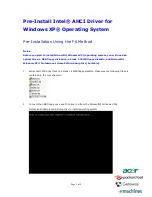
CHAPTER 23. LIVE INSTRUMENT REFERENCE
377
The Noise subsection simulates the impact noise caused by the mallet striking the fork. The
Decay knob adjusts how long it takes for this noise to fade to silence, while the Pitch control
sets the center frequency. Level adjusts the overall volume of the noise component. An
additional Key scaling control adjusts how much the noise volume is determined by note
pitch.
23.4.3
Fork Section
The Fork section is further divided into Tine and Tone subsections. This area is the heart of
Electric's sound generating mechanism.
The Tine subsection controls the portion of the fork that is directly struck by the mallet.
The Decay knob adjusts how long it takes the tine's sound to fade out while a note is
held. The Color knob controls the relative amplitude of high and low partials in the tine's
spectrum. Low values increase the amount of low harmonics, while higher values result in
higher harmonics. The amplitude of the tine is adjusted with the Level knob. This level can
be further modulated by note pitch via the Key scaling control.
The Tone subsection controls the secondary resonance of the fork. Decay and Level param-
eters here work in the same way as their Tine counterparts.
The Release knob applies to both the Tine and Tone areas and controls the decay time of
the fork's sound after a key is released.
23.4.4
Damper Section
The metal forks in an electric piano are designed to sustain for a long time when a key
is held. The mechanism that regulates this sustain is called the damper. When a key is
pressed, that note's damper is moved away from its fork. When the key is released, the
damper is applied to the fork again to stop it from vibrating. But the dampers themselves
make a small amount of sound, both when they are applied and when they are released.
This characteristic noise is modelled in Electric's Damper section.
The Tone knob adjusts the stiffness of the dampers. Turning this control to the left simulates
soft dampers, which produces a mellower sound. Turning it to the right increases the
















































